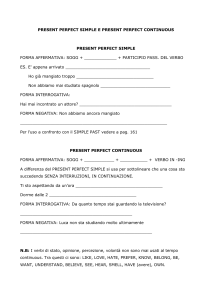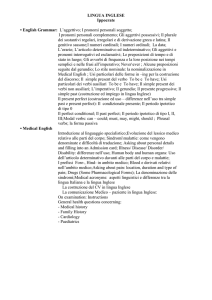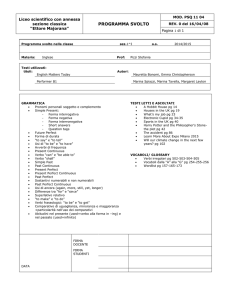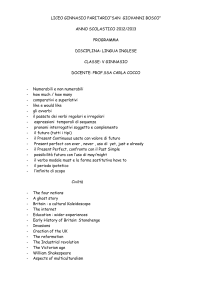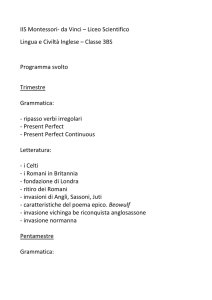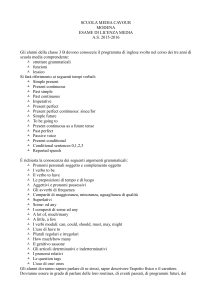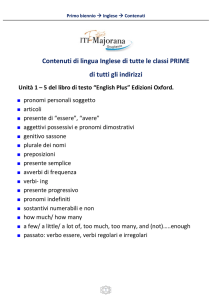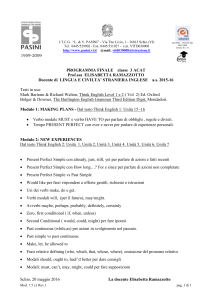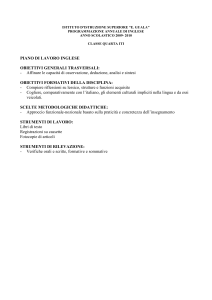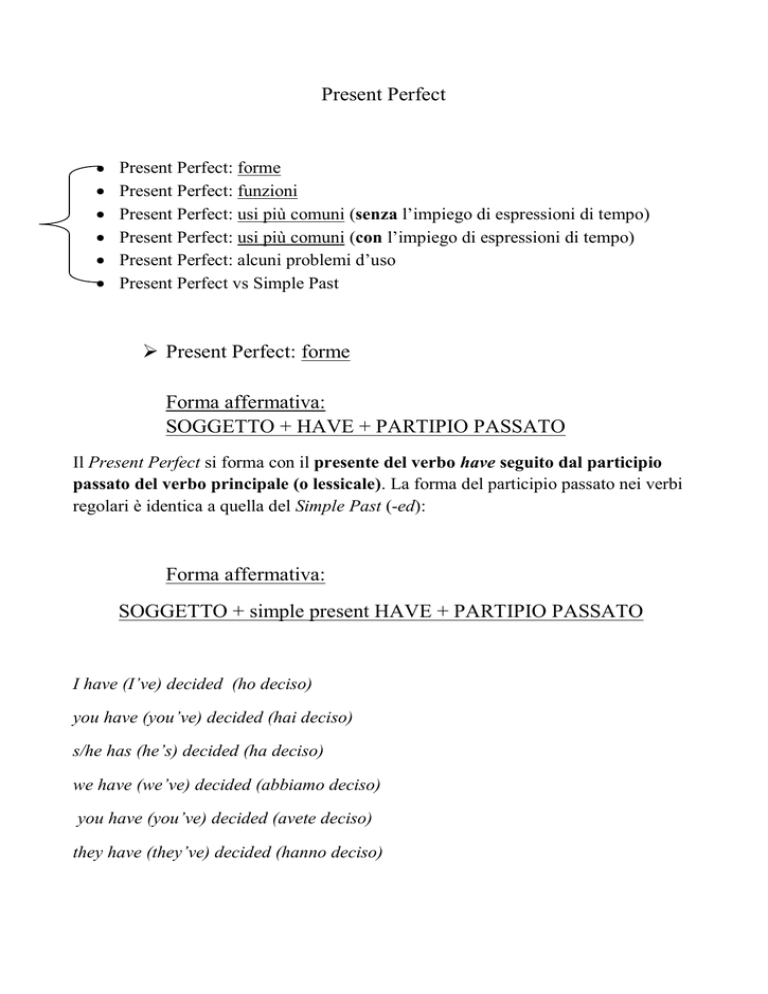
Present Perfect
Present Perfect: forme
Present Perfect: funzioni
Present Perfect: usi più comuni (senza l’impiego di espressioni di tempo)
Present Perfect: usi più comuni (con l’impiego di espressioni di tempo)
Present Perfect: alcuni problemi d’uso
Present Perfect vs Simple Past
Present Perfect: forme
Forma affermativa:
SOGGETTO + HAVE + PARTIPIO PASSATO
Il Present Perfect si forma con il presente del verbo have seguito dal participio
passato del verbo principale (o lessicale). La forma del participio passato nei verbi
regolari è identica a quella del Simple Past (-ed):
Forma affermativa:
SOGGETTO + simple present HAVE + PARTIPIO PASSATO
I have (I’ve) decided (ho deciso)
you have (you’ve) decided (hai deciso)
s/he has (he’s) decided (ha deciso)
we have (we’ve) decided (abbiamo deciso)
you have (you’ve) decided (avete deciso)
they have (they’ve) decided (hanno deciso)
Es. Forma affermativa: I have decided to leave tomorrow (ho deciso di partire
domani)
Si impiega la stessa struttura anche con i verbi intransitivi che in italiano si
costruiscono con il verbo “essere”:
Fate attenzione!! L’ausiliare è sempre have/has. Si dice:
The bus hasn’t arrived yet (NON: the bus isn’t arrived yet)
Forma interrogativa (yes/no):
simple present HAVE + SOGGETTO + PARTIPIO PASSATO
Have I decided (ho deciso)
Have you decided (hai deciso?
Has she /he decided (ha deciso?)
Have we decided (abbiamo deciso?)
Have you decided (avete deciso?)
Have they decided (Hanno deciso?)
Es. forma interrogativa: have you decided to leave tomorrow? Yes, I have. No,
I haven’t.
Forma interrogativa (wh-)
Wh- + HAVE + SOGGETTO + PARTIPIO PASSATO
What have I decided? (che cosa ho deciso?)
What have you decided? (che cosa hai deciso?
What has she /he decided? (che cosa ha deciso?)
What have we decided? (che cosa abbiamo deciso?)
What have you decided? (che cosa avete deciso?)
What have they decided? (che cosa hanno deciso?)
Forma negativa
SOGGETTO +HAVE + NOT + PARTICIPIO PASSATO
I have not decided (non ho deciso)
you have not decided (non hai deciso)
s/he has not decided (non ha deciso)
we have not decided (non abbiamo deciso)
you have not decided (non avete deciso)
they have not decided (non hanno deciso)
Es.: Forma negativa: I have not (haven’t) decided to leave tomorrow.(Non ho
deciso di partire domani)
Present Perfect: funzione
Il Present Perfect descrive azioni e situazioni passate che però sono connesse al
presente attraverso due tipi di legami: 1) legami obiettivi o 2) legami psicologici.
1) Fatti ricorrenti o situazioni iniziati nel passato ma che perdurano fino al tempo
presente e continuano a verificarsi. Generalmente, è accompagnata da un’
espressione di tempo che indica frequenza e durata:
I’ve lived here for ten years
(Abito/vivo qui da dieci anni)
2) Azioni o situazioni passate i cui effetti sono legati al presente: il processo
rivive nei suoi perduranti effetti:
Helen has broken her leg (Helen si è fratturata una gamba)
I have lost my keys (Ho perso le chiavi)
(Non sappiamo esattamente quando è successo, e la gamba è ancora fratturata. Non
compare alcuna espressione di tempo)
Il Present Perfect: usi comuni (senza espressioni di tempo)
o Viene impiegato per spiegare il motivo, fornire una giustificazione di una
situazione presente. Non viene detto quando è avvenuto il fatto.
What’s the matter? Why are you walking like that? I’ve hurt my foot
(Che cos’hai? Perché cammini in quel modo? Mi sono fatto male a un piede.
o Viene impiegato per parlare di esperienze; non vien indicato un tempo ben
preciso, ma si sottintende ‘fino ad ora’ “Time up to now).
Have you visited any other countries?
(hai mai visitato altri Paesi?)
Yes, I’ve been to Germany and France.
(sì, sono stato/a in Germania e Francia)
o Per esprimere quante cose sono state fatte, completate, ‘sino ad ora’, senza
alcuna specificazione temporale.
I’ve read a hundred pages of this book
(Ho letto cento pagine di questo libro)
Attenzione!! Particolarità riguardante il participio passato
di to go:
Differenze tra: have been to; have gone to. Come Participio
passato di to go si impiega been quando si intende andato e
tornato, e gone quando si intende andato e non ancora tornato.
Mary has been to China (adesso è qui)
Mary has gone to China (adesso è là)
Il Present Perfect: usi comuni (con espressioni di tempo)
o Si impiega spesso il Present Perfect con:
Ever, il cui si significato è ‘(non) …mai?’, nel senso di (‘qualche
volta?) e si usa di solito nelle domande:
Have you ever eaten Japanese food? (hai mai assaggiato la cucina
giapponese)
o Never che significa ‘non…mai’. Ha valore negativo e quindi si impiega senza
le forme negativa:
No, I’ve never eaten it (No, mai) No, I haven’t never eaten it.
o Yet, so far:
Yet si usa nelle domande (….yet?...già) e nelle negative (not… yet=
non ancora). So far significa “finora” e non si usa mai nelle frasi
negative.
Have you finished this book yet? (hai finito di leggere il libro? No, I
haven’t finished it yet. (No, non ho ancora finito).
How many pages have you read so far? I’ve read 100 pages so far.
o Already significa ‘già’ nel senso di ‘prima del previsto’:
When are you going to finish your letter? I’ve already written
it.(Quando finisci di scrivere la lettera? Ho già finito.
o Just indica un tempo molto recente, equivale all’Italiano “appena”.
Carol has just phoned from the airport.(Carol mi ha appena telefonato
dall’aeroporto)
Collocazione:
Already, just, ever, never si collocano tra l'ausiliare have/has e il verbo.
Ho appena finito.
I have just finished
Non l'ho mai visto.
I have never seen him.
o Recently “recentemente”
I have met him recently.(L’ho incontrato recentemente)
o Lately “recentemente/ultimamente”
I’ve been really tired lately. Ultimamente mi sento molto stanco.
Collocazione:
Yet, recently, lately si mettono alla fine della frase.
Non ho ancora finito.
I haven’t finished yet.
o Avverbi di frequenza: always (sempre), often (spesso), seldom (di rado),
rarely (raramente), ecc. La posizione degli avverbi di frequenza: prima del
verbo principale.
I’ve always seen him (L’ho sempre visto)
Alcuni problemi d’uso
o I termini generali, il Present Perfect si traduce con il passato prossimo
italiano. In altri casi può anche corrispondere al presente indicativo italiano:
Con locuzioni quali: this is the first/second time ….
(è la prima/seconda volta che …)
Have you seen this film before? No, this is the first time I’ve seen it.
(l’hai già visto questo film? No, questa è la prima volta che lo vedo)
Nelle interrogative viene spesso accompagnato da HOW
LONG? (da quando?/ da quanto tempo?):
How long….? A)For→ “da”; B)since →“da”
How long has Tom worked here?
(da quanto tempo lavora qui Tom?
A)He has worked here for three months.
(lavora qui da tre mesi)
B)He has worked here since December 10th.(Tom lavora qui da dicembre)
Uso di for e since:
Corrispondono entrambe alla preposizione italiana “da”: si usa for per
indicare la durata di un periodo di tempo (da quanto tempo…); si
impiega invece since (da quando…) con funzione incoativa, cioè
quando indica l’inizio di un periodo di tempo in cui ha avuto luogo una
determinata situazione:
I’ve had this car since 1998 (NON: *from 1998) [… dal 1998]
I’ve had this car for 19 years (NON: *from 19 years) [… da 19
anni]
John hasn’t played football since he had the accident in 2000
[John non gioca a pallone da quando ha avuto l’incidente nel
2000] (oppure: …since his accident in 2000)John hasn’t played
football for 17 years [John non gioca a pallone da 17 anni]
Il Present Perfect potrebbe essere confuso con il Past Simple,
poiché entrambi i tempi si traducono spesso con il passato
prossimo italiano:
Traduzione:
Hai visto ‘The fast and the furious?’
Hai visto il film ieri sera?
Have you seen ‘the fast and the furious?’
(hai visto ‘the fast and the furious?’)
Did you see the film last night?
(hai visto il film ieri sera?)
Solitamente, il Past Simple viene impiegato quando ci si
riferisce a un tempo completamente passato, ovvero con
espressioni quali: when, what time, yesterday, last week, two
days ago, ecc.)
When did you arrive in Prague?
(Quando sei arrivato/a a Praga?)
I arrived here in September two years ago.
(Sono arrivato qui in settembre due anni fa)
Se non dovesse esserci un riferimento a un tempo del tutto
trascorso, il passato prossimo italiano si traduce con il Present
Perfect:
Has the taxi arrived? No, it hasn’t arrived.
(è arrivato il taxi? No, non è ancora arrivato)
Simple Past contrasted with Present Perfect
Il simple past marca la compiutezza e il distacco rispetto al presente. In linea di
massima indica un’azione A) sempre collocata in un momento anteriore
rispetto al momento attuale; B) priva di legami obiettivi con il tempo presente.
Generalmente viene impiegato con gli avverbiali di tempo definito (es.
yesterday, last weekend, three years ago, in 1970, ecc.).
o I saw Lucy yesterday. (NOT: I’ve seen Lucy yesterday).
o Tom was ill last week. (NOT: Tom has been ill last week).
o She died three years ago. (NOT: She has died three years ago).
1) Il present perfect invece si impiega quando si tratta di esprimere un’azione
passata che è collegata al presente attraverso un legame obiettivo:
I’ve lived in Cagliari for 6 years. (vivo a Cagliari da 6 anni)
2) Il present perfect qualifica invece un’azione che può essere, sì, relativa al
passato, ma nella quale il processo rivive nei suoi effetti successivi, collegando
l’azione passata con un implicito risultato attuale:
He has lost the key (ha perso le chiavi)
Collega il fatto di ‘aver perso le chiavi’ con un implicito risultato attuale, ad
esempio : a) non può entrare a casa, salire in macchina, ecc.
Conseguentemente impiegate il Present Perfect con:
1) Eventi passati collegati al presente
Si impiega il present perfect ogni volta in cui emerge la ‘rilevanza attuale’
del processo, ovvero i perduranti effetti che un determinato processo può
avere nel momento presente. Ad esempio, se diciamo ‘something has
happened’ (è successo qualcosa), stiamo pensando contemporaneamente sia
al passato che al presente (spesso infatti il present perfect si può
commutare con una frase al presente senza con ciò modificare il
significato della frase):
o He has broken his leg. (Si è fratturato una gamba) (His leg is broken
now)
o Some fool has let the cat in. (The cat is in)
o Our dog has died. (Our dog is dead)
o All the wars in history have thought us nothing. (We know nothing)
Non si usa il present perfect qualora non vi fosse alcun riferimento al presente:
o A) Es: I’ve travelled in Africa a lot. (I know Africa)
o A1) Some people think that Shakespeare travelled a lot in Germany.
(NOT: Some people think that Shakespeare has travelled…)
o B) We’ve learnt enough to pass the exam. (Abbiamo studiato abbastanza
per passare l’esame) Now, we are prepared to sit for the exam. (L’esame
lo dobbiamo ancora sostenere)
o B1) We learnt enough to pass the exam. (l’esame lo abbiamo già
sostenuto)
2) Per parlare di esperienze. Non viene indicato un tempo preciso ma si
sottintende: “time up to now” (fino ad ora). Ad es. quando vengono
impiegati avverbi di tempo indefinito: ever, never, yet, already, ecc.
o Have you ever seen a ghost? (Hai mai visto un fantasma?)
o Have you ever visited any other countries? (Hai mai visitato altri
Paesi)
o She’s has never apologized for anything in her life. (Non si è mai
scusata di nulla in tutta la sua vita)
Con gli avverbi di tempo definito (es. yesterday, last weekend, ecc.) si impiega
invece il simple past.
3) Per parlare di cose che siano state completate ‘sino ad ora’.
o Es: I’ve read a hundred pages of this book. (ho letto 100 pagine …)
o I’ve written six letters since lunchtime. (ho scritto 6 lettere dall’ora
di pranzo)
o I’ve studied hard for years.(ho studiato tanto per anni)
Altre differenze: il present perfect si usa per descrivere azioni e situazioni passate
che sono connesse al presente o producono un effetto nel presente; tuttavia, si
impiega il simple past per identificare la persona, la cosa, o la circostanza ritenute
responsabili della situazione attuale (ad esempio quando si usano le domande Wh-)
,poiché in tal caso l’enfasi è sulla causa e non sul risultato che tale causa può avere
nel momento presente.
o A)Es: Some fool has let the cat in. (focusing on the present result [enfasi
sull’effetto]).
o A1 ) Who let the cat in? (NOT: Who has let the cat in?) (focusing on the
past cause [enfasi sulla causa])
o B) Look what (Jane) has (been) given me! (focusing on the present
result [enfasi sull’effetto]).
o B1) Who gave you that watch? Jane gave me that watch. (NOT: Who
has given you that watch). (focusing on the past cause [enfasi sulla
causa])
o C) I’ve broken my hand. (focus on the present result [enfasi
sull’effetto])
o C1 When /where/how did you break it? (focus focusing on the past cause
[enfasi sulla causa].
Exemple of Use
“Christian Barnard, 73, was born in Cape Province, South Africa. He
performed (1) the first human heart transplant operation in 1967 […]. Now
retired, he has home in Cape Town and Cape Province. As well as his many
medical publications, he has written (2) three novels”.
1) Past Simple: this is clearly defined and qualified by in 1967- a
finished period of time.
2) Present Perfect: no time is specified – we understand that this
is during his life and that he is still alive.
Antonio Piga

